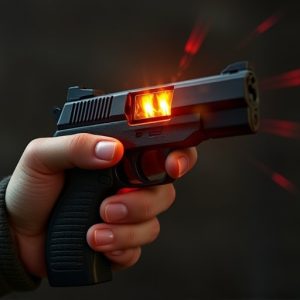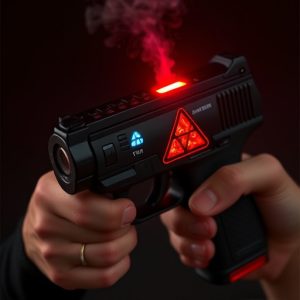Unveiling Triad Stun Guns: Overcoming Concealed Detection Challenges
The growing popularity of compact and concealable self-defense tools like the Triad Stun Gun has hig…….
The growing popularity of compact and concealable self-defense tools like the Triad Stun Gun has highlighted the need for more advanced concealed weapon detection methods. Traditional metal detectors are ineffective against non-metallic, low-power stun guns due to their stealth design. Future security measures will likely include advanced imaging technologies such as thermal scanners, terahertz radiation, and AI pattern recognition algorithms. Wearable sensors or smart clothing could also be employed to actively signal the presence of a Triad Stun Gun, enhancing checkpoint security personnel's capabilities.
In today’s world, concealed weapon detection is a paramount concern for security. With the rise in hidden stun guns, especially the powerful Triad stun gun, existing security measures are being pushed to their limits. This article delves into the growing issue of concealed stun gun detection, examining the capabilities and limitations of current systems. We explore the impact of high-power weapons like the Triad stun gun and present potential solutions and future technologies aimed at enhancing security in various settings.
- Understanding Concealed Stun Gun Detection: A Growing Concern
- The Triad Stun Gun and Its Impact on Security Measures
- Challenges in Detecting Stun Guns: Why Current Systems Fail
- Potential Solutions and Future Technologies for Stun Gun Detection
Understanding Concealed Stun Gun Detection: A Growing Concern
In today’s world, concealed weapon detection has become a pressing issue, especially with the increasing popularity of stun guns like the Triad Stun Gun. As more individuals opt for self-defense tools, ensuring safety and security in public spaces takes on new significance. The concern lies in the fact that these weapons, when hidden, can be difficult to detect, leading to potential risks during routine security checks or emergency situations.
The Triad Stun Gun, with its compact design and non-lethal force capabilities, raises questions about how best to identify such devices. Traditional metal detectors may not be effective against the advanced materials used in modern stun guns. This has prompted a need for more sophisticated screening methods, pushing security protocols to evolve and adapt to these new challenges.
The Triad Stun Gun and Its Impact on Security Measures
The Triad Stun Gun has emerged as a significant development in personal defense technology, offering individuals an additional layer of security against potential threats. This innovative device is designed to be compact and easily concealable, allowing users to carry it discreetly while maintaining a sense of safety. Its impact on security measures is profound, particularly in scenarios where speed and surprise are crucial. The stun gun’s ability to deliver a powerful electrical shock can incapacitate an assailant temporarily, providing the user with an opportunity to escape or seek help.
With its advanced features, the Triad Stun Gun promises to enhance personal safety without drawing unnecessary attention. This concealed weapon is not only a deterrent but also a reliable tool for self-defense, ensuring that individuals can protect themselves in various environments. As concerns about personal security continue to grow, such innovative solutions play a vital role in empowering people to take control of their safety.
Challenges in Detecting Stun Guns: Why Current Systems Fail
Stun guns, often referred to as electroshock weapons, pose unique challenges for detection systems due to their design and intended use. Traditional metal detectors and security devices struggle to identify stun guns effectively because they don’t rely on metallic components. Many stun guns, especially the compact and lightweight models like the triad stun gun, are designed with non-metallic materials to enhance stealth, making them virtually invisible to standard security measures.
Current detection systems often rely on electromagnetic interference or metal-based sensors. However, the low-power operation of stun guns means they produce minimal electromagnetic signals, and their non-metallic construction prevents them from triggering metal detectors. Even advanced technologies like X-ray machines and specialized imaging devices may not be sufficient, as some stun guns are designed to absorb or reflect these types of scans. This creates a significant gap in security measures, highlighting the need for innovative detection solutions tailored specifically to address the unique attributes of stun gun technology.
Potential Solutions and Future Technologies for Stun Gun Detection
Potential solutions to detect concealed stun guns include advanced imaging technologies, such as thermal and terahertz scanners, which can identify unusual shapes or materials under clothing. These non-invasive methods can be employed at checkpoints without causing discomfort to individuals. For instance, terahertz radiation can penetrate fabrics to a certain depth, allowing for the detection of metal objects like stun guns.
Future technologies may involve integration of artificial intelligence (AI) and machine learning algorithms to analyze sensor data more effectively. AI-driven systems could learn to recognize unique patterns associated with various types of stun guns, improving accuracy and speed of detection. Additionally, wearable sensors or clothing infused with smart materials could be developed to actively signal the presence of a stun gun, providing an early warning system for security personnel.
As our understanding of concealed weapon detection evolves, it’s clear that the triad stun gun poses unique challenges. While current systems have their limitations, exploring innovative solutions through advanced technology is crucial. By focusing on heightened sensitivity, improved accuracy, and comprehensive training for security personnel, we can better navigate the complexities of detecting stun guns like the triad model. This ensures public safety and addresses growing concerns in today’s security landscape.


